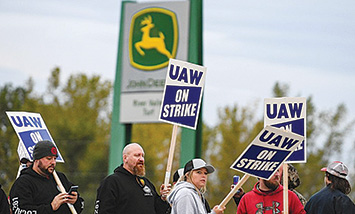Some guidelines and rules to consider when supporting workers during ‘Striketober’
 By KRIS LaGRANGE
By KRIS LaGRANGE

Over the last few months, there has been a wave of strikes. Nurses in Buffalo and Massachusetts, miners in Alabama, and strikes at Nabisco, Frito Lay, and now Kellogg’s are just a few of the strikes that have taken place over the last few months. Additionally, some 10,000 UAW members walked out last week at John Deere, and IATSE members have approved a strike if talks break down and could walk out any day now. (A tentative settlement was reached last week.)
With so much action going on, some people have started to refer to October as Striketober and the strikes have gotten so numerous since the pandemic started that PayDay Report put together a tracker just to keep up. (interactive map at paydayreport.com/covid-19-strike-wave-interactive-map/)
With so many strikes going on, people may wonder what they can do to help. While some union members are well versed in this, many union and non-union workers are not, so UCOMM decided to put together a guide to help you navigate the do’s and don’ts when someone is on strike.
PUBLIC SUPPORT
The best way you can help is to walk a picket line.
Remember, these are men and women from your community, and giving them community support will not only increase their spirit, but it will also show the bosses that the union, not the company, has the support of the community.
When you get to the picket line, make sure to talk to them about why they are on strike and let them know that you have their back. You may also want to take pictures on the picket line or do a live stream to help get their message out to your friends.
If you are in a union or community group, try to organize a trip to the picket line.
Few things will lift their spirits more than a group of people showing up to hold the picket line down for a few hours in support of these brave workers. When you show up with a large group of people, this also gives the workers some “time off” to regroup. Remember, walking the picket line is their full-time job when they are on strike and it can be hard work.
Whenever you drive by a picket line, make sure to honk and wave. This lets the strikers know you support their fight and lets everyone around you know that the striking workers have community support.
HELP FEED, TAKE CARE OF THEM
Strikes are expensive both for the union and for the workers.
While unions have strike funds to help provide some money for the members while on strike, it doesn’t come anywhere close to what they were making on the job. For example, Kellogg workers will get just $105 a week in strike pay. The workers also usually lose their health insurance when they go on strike.
These are tactics used by the company to starve the workers until they are so desperate that they will accept a bad contract. However, you can help.
Many unions set up strike funds that the public can donate to so that the costs can be lowered. This allows the union more flexibility to help workers stay on strike and keeps the solidarity strong.
You can also help by donating food and other essential items. When you head to a picket line, it is a great idea to pick up some cases of water, some coffee, pizza or donuts. Of course, a home-cooked meal is never rejected, so if you are into cooking, make them some of your famous lasagnas or fire up the grill and bring it down to the picket line.
It is also a good idea to donate things like ponchos for when it rains or hand warmers if you are in a cold-weather area. Just imagine – if you had to walk a picket line outside in Michigan in the late fall, you would definitely be glad to have some hand-warmers and a hot cup of coffee.
If you don’t live in the local area, call your local pizzeria and send some pies over or order food through an app like Doordash. The strikers will definitely appreciate the gesture and it will help them stay One Day Longer, One Day Stronger.
Another key thing to remember, especially as we head toward the holidays. When a strike happens, it isn’t only Dad or Mom who is out on strike, it is the whole family. This means that they might not be able to provide presents for their kids at Christmas or a Thanksgiving dinner for the family. Especially around the holidays, consider making donations that will support the kids as well as the strikers.
BOYCOTT
Rule number 1 of a strike is don’t cross the picket line. For our non-union readers, this means do not enter a business with a strike going on in front of it. (If you) really need that item from the store, go to another retailer. If you cross a picket line, especially to work, you will be considered a scab.
Now this becomes complicated when a union like Verizon goes on strike. Consumers are locked into a contract for a service that is deemed essential so you can’t always just stop service. In this case, it is important to listen to what the union is suggesting you do. They may say pay your phone bill but send it in via or over the phone so that you jam up their system.
Another way to support the workers is through a consumer boycott.
When workers at companies Frito Lay, Nabisco or Kellogg’s are on strike, it is important that you not buy these brands. There is one caveat that goes along with this though, make sure you listen to the union about which brands to boycott. Many of these companies are now so vertically integrated that they may have multiple union contracts that cover different brands.
For example, if IATSE goes on strike studios like Netflix, Disney, Marvel, and Universal would be affected, but premium cable companies like HBO would not since they have a different contract that is not yet expired. Same thing with the current Kellogg’s strike – while the cereal division is on strike, the snack division is not. Yes, it can get very confusing.
AMPLIFY THE STRIKE MESSAGE
A great way to support a strike is to make sure that everyone knows about it.
If the newspaper isn’t covering it or is covering it in a negative way, coordinate a letter to the editor campaign to let the public know the real story from the picket line. You can also coordinate calling in to local news radio programs to let them know about the strike. These are great ways to force the media to cover the strike and to amplify their message.
You can also use your social media to get their message out there. Change your social media avatar to show your support for the workers, post about the strike on your feed and generally get the message out to the public that a strike is taking place. Too often these strikes are not covered by the mainstream media, so using your networks to get information out about the strike is vital. You may also want to take pictures on the picket line or do a livestream to help get their message out to your friends.
Just remember when posting about the strike, these workers’ lives have been turned upside down. Many of them are struggling or soon will struggle to pay their bills and some may lose their homes or get divorced. Don’t post happy photos of your day getting to play union activist. When you post photos of everyone looking happy, it shows the public that the workers are happy to be on strike and not working, a message that we don’t want to unintentionally send.
Finally, you may want to coordinate a campaign to send messages to the company letting them know about your displeasure with how they are treating their workers. This pressure will let them know that their customers don’t approve of their anti-union ways.
(Kris LaGrange is the head of UCOMM Communication, a Labor-focused communications firm specializing in internal and external communications for local unions and labor councils. Edited and reprinted from UCOMM Blog.)


Do you know of any way to donate money? I don’t personally know any striking workers but definitely would like to support any striking worker.
The best way is to donate to the St. Louis Labor Council’s $5 for the Fight fund https://labortribune.com/5-for-the-fight/